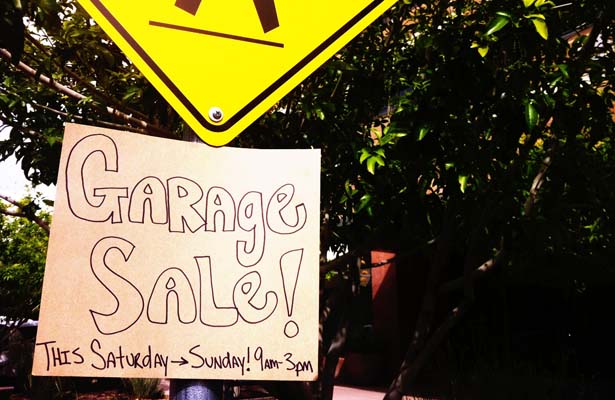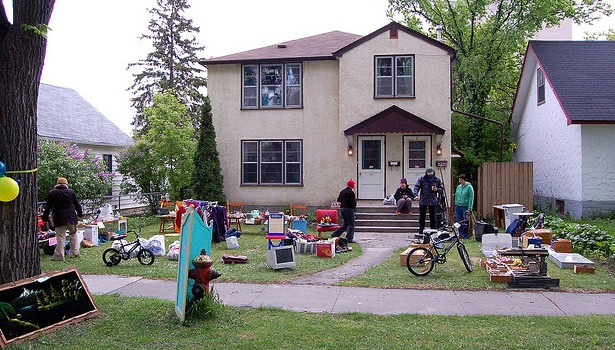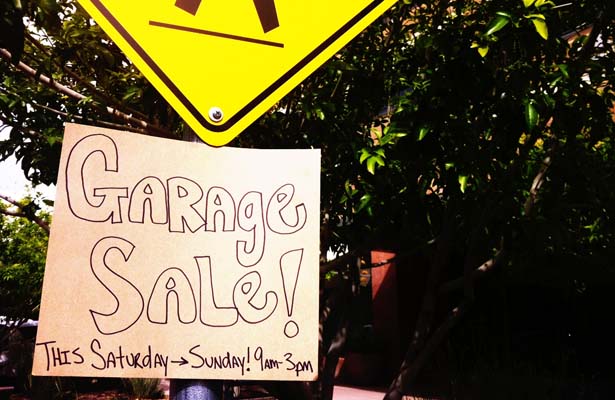This article originally appeared on Earth911.com and is republished with permission.
In October, hundreds of bargain hunters will descend upon El Cerrito, California, a San Francisco bedroom community just north of Berkeley, for the city’s semiannual citywide garage sale. About 65 homes will host individual garage sales, and shoppers can drive from sale to sale, securing deals on secondhand goods that might have otherwise ended up in the landfill or languished in storage.
The idea for El Cerrito’s citywide garage sale was conceived back in 1989, when the Loma Prieta earthquake devastated the San Francisco Bay Area, killing 63, starting fires and bringing down freeways. After the natural disaster, El Cerrito’s fire department began to inspect home foundations for structural damage, but kept running into a recurring problem; garages packed with old stuff that prevented officials from accessing and checking foundations.
To clear these unwanted items from garages for safety inspections – and to benefit the environment by promoting reuse – local resident and reuse advocate Marianne Hegeman approached the city about organizing a citywide garage sale.
In October 1990, El Cerrito held its first citywide garage sale, and the event was such a success that the city has since made it an annual tradition. Now in its 23nd year, the garage sale is as popular as ever, expanding from one Saturday in October to two events per year: one in May and one in October.

Bigger is always better when it comes to garage sales. Photo: Alex Vietti, Earth911. Used under Creative Commons license.
A few years ago, neighboring city Albany decided to host its own citywide garage sale, too, and now the two East Bay cities coordinate their events to fall on successive weekends.
“[The citywide garage sale] helps people clear the clutter out of their homes and encourages reuse, putting unwanted items back into circulation,” says Garth Schultz, environmental analyst for the city of El Cerrito. “People look forward to the event; it gives them a chance to meet their neighbors and brings a sense of community…[the garage sale] has multiple benefits.”
Tips to start your own citywide garage sale
Want to organize a citywide garage sale in your own community? Schultz offers these step-by-step instructions to get started:
Want to organize a citywide garage sale in your own community? Garth Schultz, environmental analyst for the city of El Cerrito, offers these step-by-step instructions to get started:
1. Find a sponsor.
Bring the idea of a citywide garage sale to your city, a local nonprofit, community organization or neighborhood group and see if they are willing to sponsor the event, Schultz says.
The first question the group may ask is; How much money will it cost to coordinate the citywide garage sale?
To ease concerns about funding the event, Schultz recommends charging a small registration fee to residents signing up to host sales at their home; El Cerrito charges $12 per house. The revenue will pay for the costs of organizing the event: purchasing ads and printing maps of the sales.
“We aren’t spending more money than we bring in through registration fees,” he says.
The sponsoring organization will, however, need to dedicate some of its staff time to event coordination that won’t necessarily be covered by registration fees. Schultz estimates that El Cerrito’s city staff spends about 25 hours organizing each event, for a city of 25,000 residents with 65 garage sales per event.
But it is important that the garage sale has a lead coordinator – one point of contact to plan and execute all event logistics, Schultz says. That organizer may be staff from the sponsoring organization or an enthusiastic volunteer from the community, like you.
 A garage sale by any other name is just as sweet. Photo: Flickr/Dano. Used under Creative Commons license.
A garage sale by any other name is just as sweet. Photo: Flickr/Dano. Used under Creative Commons license.
2. Sign up the sales.
Once you’ve found a backing organization and designated a lead organizer, you’ll need to create a registration form to sign up residents to host garage sales at their homes. The registration form can be a printed copy or online, but it should collect such information as the resident’s name and contact information, the street address of the garage sale and a brief listing of any special sale items to interest shoppers.
To find garage sale hosts, send out the form through city or community newsletters and email lists and post the form on popular local websites and community bulletin boards.
While each community is different, Schultz has found that 65 is a good number of sales for El Cerrito’s citywide garage sale. When the city hosted the event once a year, over 120 sales would sign up, spreading shoppers thin over too many garage sales.
3. Spread the word.
To find shoppers for your citywide garage sale, you’ll want to promote the event through avenues that reach avid garage sale shoppers best. Use registration revenue to purchase ad space in popular local newspapers or websites, but don’t forget about free means of advertising: local bulletin boards, publications’ community calendars, press releases, newsletters and Craiglist.org.
Schultz also suggests asking garage sale hosts to help publicize the event, posting signs in their neighborhood or placing their own free ads on Craiglist.org or other websites.
4. Draw up directions.
For each citywide garage sale, El Cerrito compiles a list of all individual garage sales – their street address and a listing of sale items – and designs a map, which displays the sales’ locations. The city distributes these lists and maps to garage sale shoppers online and in printed copies available in self-serve literature stands throughout the community.
While El Cerrito uses a professionally designed map template that in-house staff can update each year, you can experiment with the type of map and list that will work best with the resources your organization has at its fingertips. It can be as elaborate as a high-quality map produced by a graphic designer or as simple as pinning garage sale locations on a Google Map and sharing the link.
5. Ask for feedback.
On the day of the event, stop by a few of the garage sales and gather information from the hosts that can help improve the next citywide sale: How many shoppers did they receive? Did the shoppers come all at one time or was there a steady flow throughout the day? Where did the shoppers hear about the sale?









